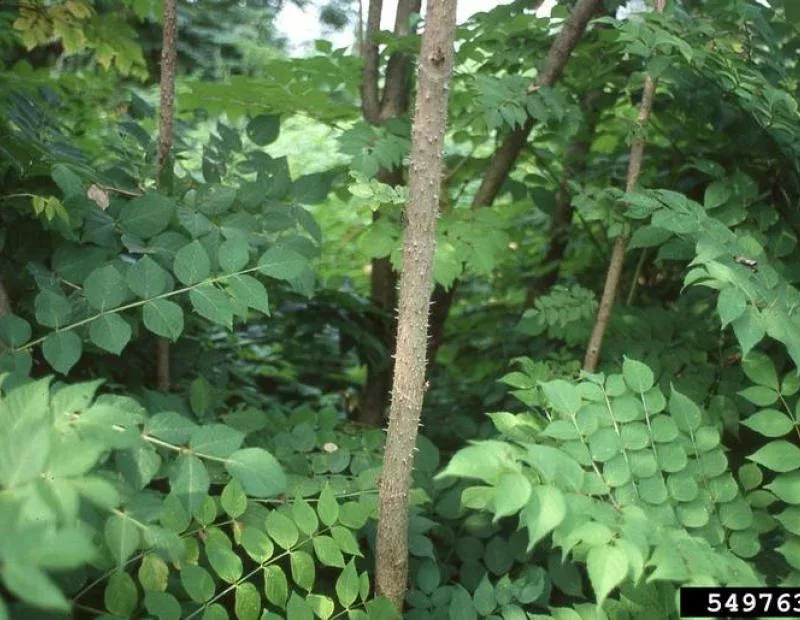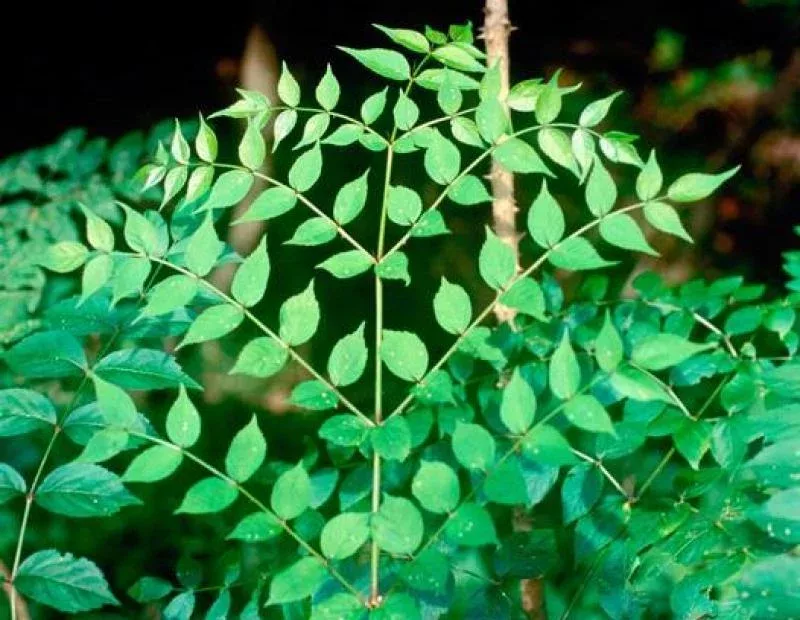
Japanese angelica tree is a member of the Carrot family (Apiaceae). It is capable of growing to almost forty feet in height at a rate of two feet in a single season. Its large bipinnately (i.e., "double, feather-shaped") compound leaves are relatively unique in the understory of the Hudson Valley’s forests. Leaves are arranged alternately and bear 6-9 pointed leaflets. The species is most conspicuous when it blooms an inflorescence of white flowers, sometimes as wide as two feet across, in late August. These flowers are wider than they are tall, radiate from separate stems within a cluster and lack a central axis. Japanese angelica tree stems are covered in sharp spines. (3) The fruits are small purple to black berries and generally appear in September. (3)

Japanese angelica tree is commonly found in disturbed woodlands and edge habitats such as old fields, thickets, hedgerows and occasionally along open, sunny streams and rivers. (5)
STEM
Stems are covered in sharp thorns on a greyish brown smooth bark.

Photo credit: bugwood.org
LEAF
Leaf is doubly compound with a fern-like appearance and having many leaflets, with vertical thorns at each leaflet axil.
FLOWER
Flowers in large, dense white clusters from July-August. Flowers radiate from separate stems within the cluster with no central axis

Photo credit: T. Davis Sydnor, The Ohio State University, Bugwood.org
As a relatively recent invader in the Northeast, very little is yet known about the reproductive potential of Japanese angelica tree. The species is a prolific producer of viable seed and is capable of vegetative growth as well: a single plant can quickly become a large colony. More germination and seed viability trials and research are needed. (5)

Biological Control
There are currently no biological control agents in use against this species.
Manual or Mechanical Control
Pulling / Digging Up: Hand pulling or digging young plants is effective if performed prior to seed set. Larger individuals must be removed using a weed wrench, however, the species has a tendency to create root sprouts if a significant amount of material is left in the ground. (3)
Mowing: No information available
Girdling: Not applicable
Prescribed Fire: No information available
Prescribed Grazing: Although there is anecdotal evidence deer do browse Japanese angelica tree, no information is available on the utility of grazing as a management tool for this species.
Soil Tilling: No information available
Mulching: Mulching may help reduce the seed bank and cover bare ground after infestations have been controlled via spraying and or pulling, however, this will also reduce the reestablishment of other, native vegetation in the area, too
Solarization: Not applicable
Hot Foam Spray: No information available
Chemical Control
The pesticide application rates and usage herein are recommendations based on research and interviews with land managers. When considering the use of pesticides, it is your responsibility to fully understand the laws, regulations and best practices required to apply pesticides in a responsible manner. At times, the pest you seek to treat may not be on a pesticide label, requiring a 2ee exemption from NYSDEC. Always thoroughly read the label of any pesticide and consult the NYSDEC or a licensed pesticide applicator with questions.
Foliar Spray: 1% glyphosate is very effective for trees less than 8’ in height.
Cut Stump: Effective with ~13% triclopyr (oil carrier) or ~50% glyphosate with water carrier
Basal Bark: Effective, with ~13% triclopyr using oil carrier.
Hack-And-Squirt
Stem Injection: Not applicable
Pre-Emergent Spray: No information available
General management overview and recommendation
As with any other invasive infestation complex, large stands of Japanese angelica tree are best managed via a combination of mechanical and chemical means. Small plants and seedlings can be hand pulled while larger individuals will be best controlled by cut stump treatments towards the end of the growing season. All managed infestations should be monitored for at several years to check for new seedlings and to prevent reinvasion from nearby populations. (6)
Post treatment monitoring
Controlled populations should be revisited twice a season for several years.
Disposal Methods
Japanese angelica tree can be chipped and composted unless the plant has already formed viable seed heads, in which case all reproductive parts must be bagged and disposed of.
